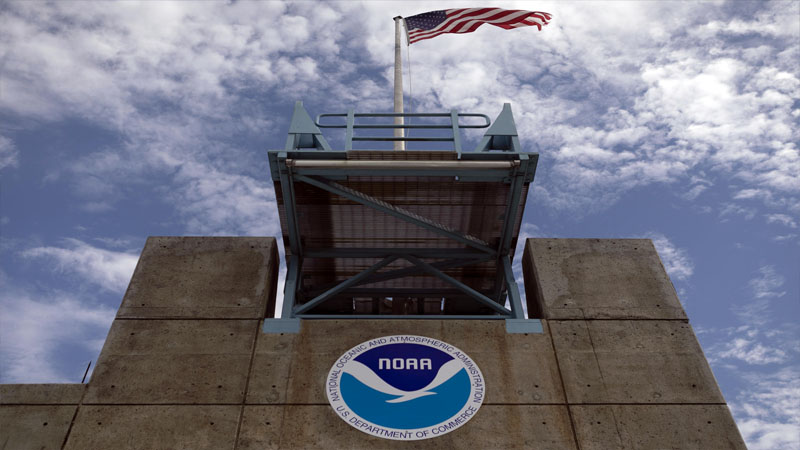Exclusive content

The United States ranks as the world’s sixth-largest producer of wild-caught seafood, an industry that sustains 2.3 million jobs and generates $321 billion annually. NOAA’s Marine Fisheries Service (NMFS), employing some 4,200 of the agency’s pre-layoff workforce of 13,000, oversees the management, conservation, and protection of these marine resources, including the shrimp that graces nearly half of American dinner tables.
For the shrimp industry, NOAA’s role is indispensable. Wild-caught shrimp, prized for its sustainability, faces relentless competition from a deluge of farmed imports—90% of the U.S. market—that often skirt environmental and labor standards. By monitoring fish stocks, setting harvest quotas, and enforcing regulations like turtle excluder devices, NOAA ensures the viability of domestic shrimpers against these cheaper, frequently illegal foreign rivals, preserving both ecological balance and economic livelihoods.
Layoffs Threaten NOAA’s Operational Efficacy
Yet NOAA now confronts a storm of its own making—or rather, that of budget cutters. Layoffs targeting up to 20% of its payroll, part of an efficiency push championed by figures like Elon Musk, have already claimed at least 20 staff at key fisheries hubs in Narragansett, Rhode Island, and Woods Hole, Massachusetts. These reductions threaten to erode the agency’s capacity to gather the data and issue the regulations that underpin fishery management, a concern echoed by Rick Spinrad, NOAA’s former administrator under President Joe Biden, who decried the cuts as “unnecessary and malicious.”
The shrimp industry stands to feel this pinch acutely. Delays in data collection or regulatory enforcement could disrupt fishing seasons and quotas, leaving shrimpers vulnerable to market fluctuations and import pressures. The New England Fishery Management Council’s warning of potential delays to the groundfish fishery’s traditional May 1 opening hints at broader disruptions that could ripple through to shrimp, amplifying the stakes of NOAA’s diminished workforce.
Shrimp Industry Faces Unique Challenges
Shrimp, America’s favorite seafood, exemplifies the tension between sustainability and market reality. Unlike domestic farmed shrimp, which accounts for less than 1% of the market, wild-caught varieties rely on NOAA’s oversight to compete with the 90% of shrimp imported from abroad. These imports often come from regions with lax standards, undercutting U.S. shrimpers who lack the federal subsidies afforded to traditional agriculture or aquaculture, a grievance long held by fishing communities.
Bryan Jones, vice president of the South Carolina Shrimpers Association, encapsulates this frustration: “The entire seafood industry would like to see a mindset shift. What is the purpose of NOAA? Why do they exist?” His words reflect a broader sentiment that NOAA’s priorities have drifted, leaving shrimpers to fend off foreign competition with little tangible support, even as the agency’s staffing crisis deepens their plight.
Reduced Oversight Could Lead to Overfishing
History offers stark warnings of what happens when NOAA’s data falters. The 2020 suspension of the Bering Sea bottom trawl survey during the COVID-19 pandemic left gaps in snow crab data, contributing to a fishery collapse the following year after a marine heat wave slashed the population by over 90%. Similarly, this year’s overfishing of Atlantic bluefin tuna off North Carolina—blamed on NOAA’s failure to close the fishery post-quota—underscores the peril of lax oversight, a scenario shrimp could soon face.
For shrimpers, reduced monitoring might trigger overly cautious quotas, shrinking harvests and profits, or, worse, permit overfishing that jeopardizes stocks. The 2018 winter freeze that decimated Charleston’s white shrimp, followed by NOAA’s sluggish distribution of $1 million in disaster relief—still incomplete nearly seven years later—illustrates the agency’s capacity for delay, a vulnerability now magnified by layoffs.
Industry and Expert Perspectives
Not all shrimpers mourn NOAA’s struggles; some, like Jones, entertain thoughts of “burn it down, start fresh.” Yet experts argue the agency’s role remains vital. Sally Yozell, former Deputy Assistant Secretary for Oceans at NOAA, defends science-based management: “It’s not fair to say to a fisherman, ‘Okay, you go and guard your own hen house.’” She credits strict oversight with rebuilding U.S. fisheries from the overfished doldrums of the 1980s and 1990s into a global model.
Sarah Poon of the Environmental Defense Fund adds that shrimp’s volatility—exacerbated by warming oceans and algal blooms—makes NOAA’s data indispensable. “Turmoil at the agency is already upending some of these decision-making processes,” she warns, a sentiment borne out by the tuna overfishing incident. For an industry reliant on precise stock assessments, NOAA’s woes spell uncertainty.
The Future of the Shrimp Industry Hangs in the Balance
As NOAA grapples with its staffing crisis, the shrimp industry teeters on a precipice. Jones fears for its survival: “There’s a chance that we may not be around in a couple of years—it’s that bad.” South Carolina’s seafood sales and shrimp boat numbers have halved since the early 2010s, and further reliance on farmed imports could deepen environmental and ethical woes abroad, from forced labor to habitat destruction.
No regime change in Washington guarantees relief, and shrimpers’ calls for a refocused NOAA may go unheeded. Commerce Secretary Howard Lutnick’s assurances against dismantling the agency ring hollow amid ongoing cuts. For now, the fate of wild-caught shrimp—and the communities it sustains—rests on NOAA’s ability to weather this storm, a task growing harder with each departing scientist.